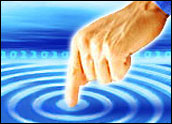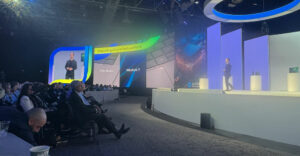
Microsoft has filed a patent application for a display screen that would dynamically give users the feeling of pushing buttons when they touch it.
It filed patent application 20100295820 last week.
The patent’s for a “light-induced shape-memory polymer display screen” that would give users the sensation of actually touching buttons as they’re displayed on a touchscreen.
At least one other project that would give users tactile sensations when they put their fingers on a touchscreen is under way elsewhere.
Microsoft Explores Your Feelings
Microsoft’s patent describes a device with a display screen that has a topography-changing layer. This layer would consist of a shape-memory polymer activated by light. It would have an imaging engine that would project visible light onto a display screen and a topography-changing engine projecting ultraviolet (UV) light onto the screen.
The UV light would, in essence, command the shape-memory layer to create buttons on the screen as required. This could provide a virtual keyboard users can interact with.
The screen would also have a reference engine that would project infrared (IR) light onto the screen and a touch-detection engine that would detect when the screen was touched. The lights would impact the polymer layer pixel by pixel.
Microsoft’s patent proposes using cinnamic acid groups for light detection. The E-isomeric form of cinnamic acid can be converted to the Z-isomer through irradiation with UV light. The technology would apparently be used first in large devices.
“A simple application would be to use this technology to create a true tactile touch keyboard where you could actually feel the keys under your fingers,” Carl Howe, director of anywhere consumer research at the Yankee Group, told TechNewsWorld.
Microsoft declined comment on the patent.
Other Efforts With Touchscreen Technology
Disney Research in Pittsburgh, Penn., is also working on a project to provide tactile feedback to touchscreens.
Its TeslaTouch project uses the electrovibration principle to provide tactile feedback to users of a touchscreen. Electrovibration, like mechanical vibration, it is a type of tactile sensation.
A handheld prototype was created in collaboration with Mark Baskinger of the Carnegie-Mellon University School of Design.
The prototype measures 35 by 4 by 40 mm and uses 8 volts of electricity to generate tactile feedback. An electrostatic force attracts the user’s fingers to the interactive surface, so the user doesn’t receive an electric charge. The input signal is spread uniformly across the touch surface.
TeslaTouch technology can be added to devices ranging from small handheld items to large multitouch collaborative surfaces. However, the user must be grounded for best results. For larger devices, this can be achieved by users wearing antistatic wristbands or sitting or standing on grounded pads. For mobile devices, the back of the device’s case serves to ground it when the user holds the device.
Uses of Tactile Feedback
It’s difficult right now to predict exactly where this type of tactile technology might be used on a large scale.
“Ideally, this would be for devices with screens which come closer to laptops and smartphones than they do to desktops,” Rob Enderle, principal analyst at the Enderle Group, told TechNewsWorld.
“However, initially monitors for existing PCs and other devices are more likely to be easier to use with this technology because the initial cost of the panel will likely limit the market significantly,” he added.
The design is part of the problem with the technology.
“The patent puts several constraints on the display and, as of now, I don’t see such constrained displays — ones where have multiple projectors behind them — having a ton of utility,” the Yankee Group’s Howe pointed out.
However, there might be niche applications, such as in the command and control center of a battleship, where the tactile feedback would help users remain oriented while the vessel is pitching and yawing, Howe suggested.
However, practical use for the technology might be some ways off.
“It’ll likely be seven to 10 years before the technology exists outside the lab in limited runs and over 10 years before it hits the broader market,” Enderle opined.






















































The lack of feedback is why I don’t like Touchscreens. The iPod Touch and iPhone are nice but just try typing a lot on them. Unless you look at the screen constantly you have no ideal where the keys are. I AM not sure this ideal from Microsoft will be much better. But hopefully they will get this patent instead of Apple.